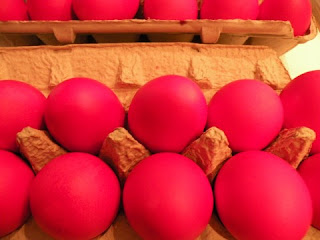It is a tradition in many Byzantine Churches, not so much in the Slavic Church, that the faithful will bring red dyed chicken eggs to Church on Holy Saturday night. These eggs are blessed at the conclusion of the service and then distributed to the people. The eggs are crack, one on another, whilst exclaiming “Christ is Risen.” There is sort of a contest involved to see who can last the longest cracking their egg.
As with everything that we do in the Church there is a tradition behind all aspects of the egg. I say tradition because there is very little theological meaning behind it but tradition is important as well.
The eggs are dyed red to symbolize the blood of Jesus Christ that has been shed for the life and salvation of the world. The hard shell of the egg represents the tomb of Jesus where He was placed after the Crucifixion. And the cracking of the eggs represents the Resurrection of Jesus from the dead.
There are of course many legends of how this all began. Some of it involves the fasting that we Orthodox partake in during Great Lent. If you follow the fast as prescribed by the Church you will not eat meat or dairy products for the 40 days. However, as I have found out, Chickens do not follow the fast and they continue to lay eggs. So as not to let the eggs spoil, and therefore wasting food, people would hard cook them and preserve them. They would then bring them to Church on Pascha to be eaten.
One of my favorite legends involves Mary Magdalene, actually there are several that involve her and many think that the tradition of the Red Eggs came from her. The story goes that on the day of Resurrection, Mary Magdalene was bringing as basket of eggs to share with the other women who had gone to the tomb to prepare the body of Jesus. If you recall the story they buried him in haste and returned the next day to complete the process of burial. When she saw the risen Christ, the eggs in her basket turned red. Hence the egg became associated with the stone that was placed in front of the tomb.
Another legend involving Mary Magdalene has her traveling to Rome. She stands before the Emperor Tiberius and presents him with an egg and says, “Christ is Risen.” Tiberius responds that if this is true this egg will turn red. Guess what? The egg turned red.
The last legend that I will share involves the Virgin Mary, mother of Jesus. The legend states that the Theotokos brought a basket of hard cooked eggs to the soldiers that were to Crucify her son. She brought them in the hopes that they would treat Him well during the task that they had to complete. As she presented the basket of eggs to one of the soldiers her tears fell on the eggs and they turned red.
So, as you can see, there are many different legends and practices involving the Red Eggs at Pascha. These are all fun traditions but should not, and cannot replace the joy of the Resurrection of Christ.
Christ is Risen! Indeed He is Risen!


Christ is risen! Which of the Slav churches do you speak of? In Russian and Ukrainian Orthodoxy the red eggs are well known, both in celebrating Pascha (when they're blessed and distributed) and in observing the Day of Rejoicing, when the faithful take them to the cemeteries to place on the graves of their loved ones as a sign of our hope in the coming resurrection.